The Article
AUVA ISOLATOR FEET FROM STACK
14th April 2023
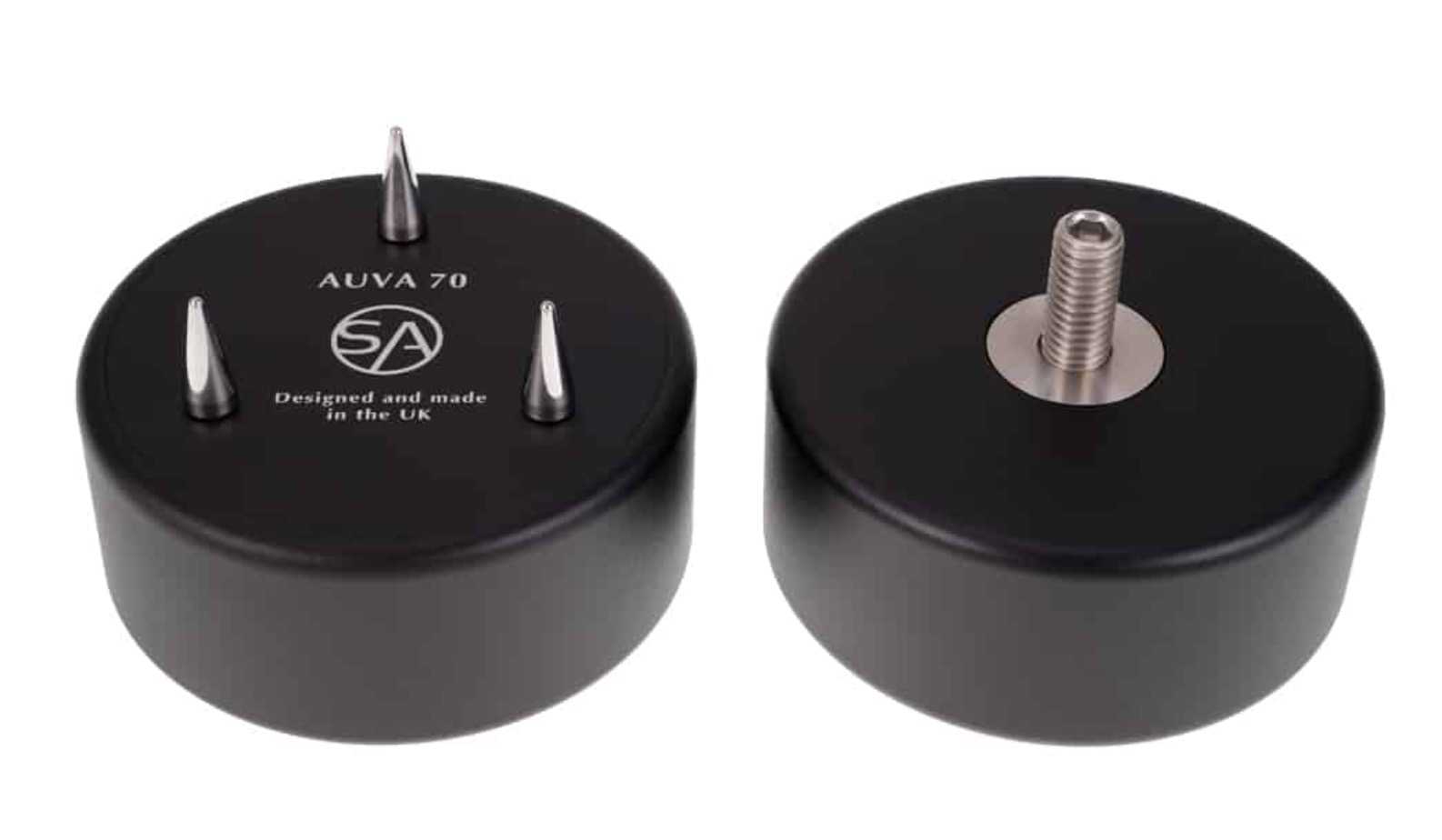
Arriving in two flavours, Paul Rigby reviews both the lower-cost AUVA 70 and higher-cost AUVA 100 isolator feet
I say lower cost, everything is relative isn’t it? Far be it from me to limit Stack Audio’s potential audience but I can see higher-end customers being the prime audience for these.
Actually, as far as I’m concerned? That means a harder and more difficult ride during this review. If you’re going to pay a lot for a set of accessories like his then they had better be good. So, for example, “Fine” won’t cut it. “They’re pretty decent,” won’t be enough, either.
When a company charges a lot for any HiFi component, I want to know why.
As such these feet are aimed directly at your speakers. They either replace the bundled, default feet or they offer feet where none were previously available. So that could be out-rigger stands on a pair of floor-standing speakers, for example or the stands which hold up a pair of stand-mounted designs. Or anything else in between, of course.
As long as the stand – or whatever it is – features a bolt hole that is either M8 (which is around 8mm) or M6 (again, around 6mm) and that should cover most if not all of them.
Thus, when hooking these feet to your speakers or stands, the bolt screws into your speaker stand and the foot, the Isolator itself, screws onto the bolt. And that’s it. You’re off and running from that point on. Well, there’s a couple of nuances but we’ll get to that in a moment.
THE TECH
Most speaker feet I know ask you to sit the speakers on a vibration-absorbing material with a promise to lower the noise floor while doing so. So they’re made from cork or cork and rubber or some sort of polymer and they might surround that with metal or whatever. And many of them do just that and do it very well.
The AUVA (AUdio Vibration Absorber) Isolator feet don’t do this. They reject that entire technology pathway.
Instead, they use a hollow pod containing cells. In the cells are loose particles (including tungsten). The vibration forces the particles to collide and the vibration is dispersed via heat. There is actually more going on here but the design is patent pending so part of the tech is secret.

This general method of vibration dispersal is not new to me but I am used to seeing it applied in Grounding accessories, power blocks and the like. Not speaker feet. So the application of this sort of tech is a first. Well to myself, at any rate.
There are two types of AUVA Isolator. The AUVA 100 is larger and features more cells (i.e. five) and more particles than the AUVA 70 (which contains three). Hence, the 100 costs more.
INSTALLATION
In my mind’s eye, I imagined that Stack Audio had designed and possibly even tested these feet with conical drivers in mind.
So I attempted to second guess my imagination and wrong-foot Stack Audio.
That is, picking up the AUVA 70 feet first, I decided to give the 70s a tough test from the off. To begin, I decided to place them under my Quad 57 electrostatic speakers.
Here, you’re looking to install some control on two sheets of shimmering cling film. To me, if you can bring a semblance of order on those, then your basic speakers will be child’s play, by comparison.
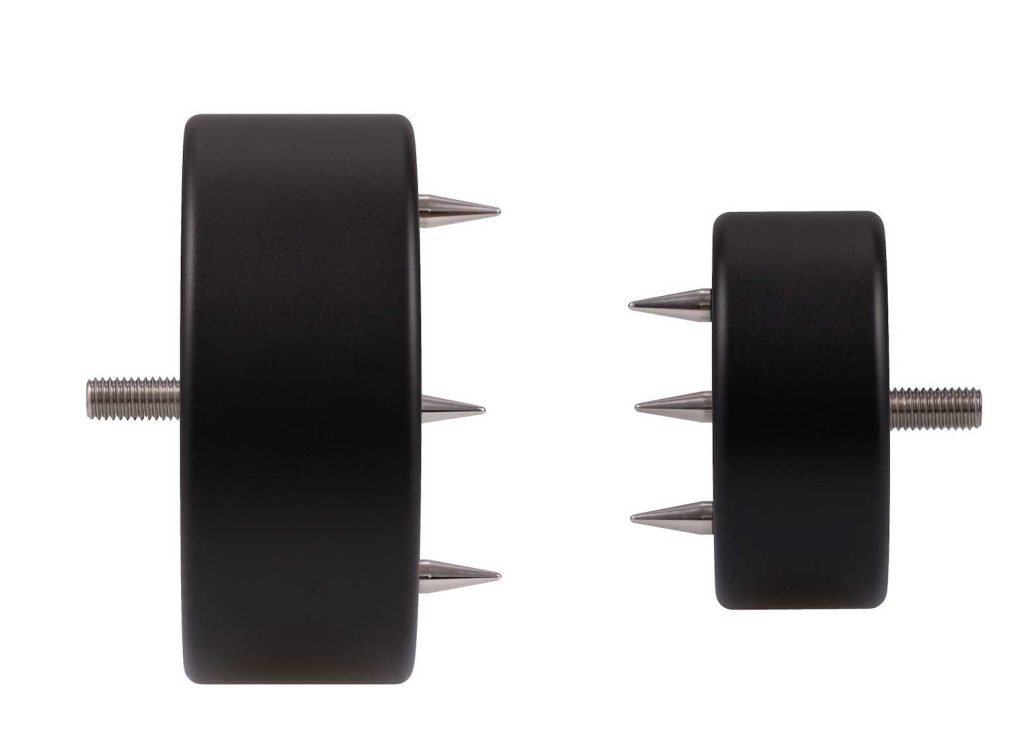
Intriguingly, the material inside the feet is loose. If you shake these feet they sound like diminutive maracas. Children could use them at parties to accompany a quick rendition of The Wheels on the Bus.
I decided to use mine under speaker stands but you’re free to follow the percussive route, if you wish.
For my Quad speakers I was happy to see a variety of attachment bolt sizes in the accompanying box, because I needed a slightly smaller bolt (i.e. M6) for the stand side and a larger bolt (i.e. M8) for the foot end. Stack thoughtfully included bolt convertors, you might say, in a plastic bag. With the M6 size at one and and the larger M8 size on the other end. Even if your stands or speakers offer a different bolt size, Stax Audio can cover any size requirements you may have.
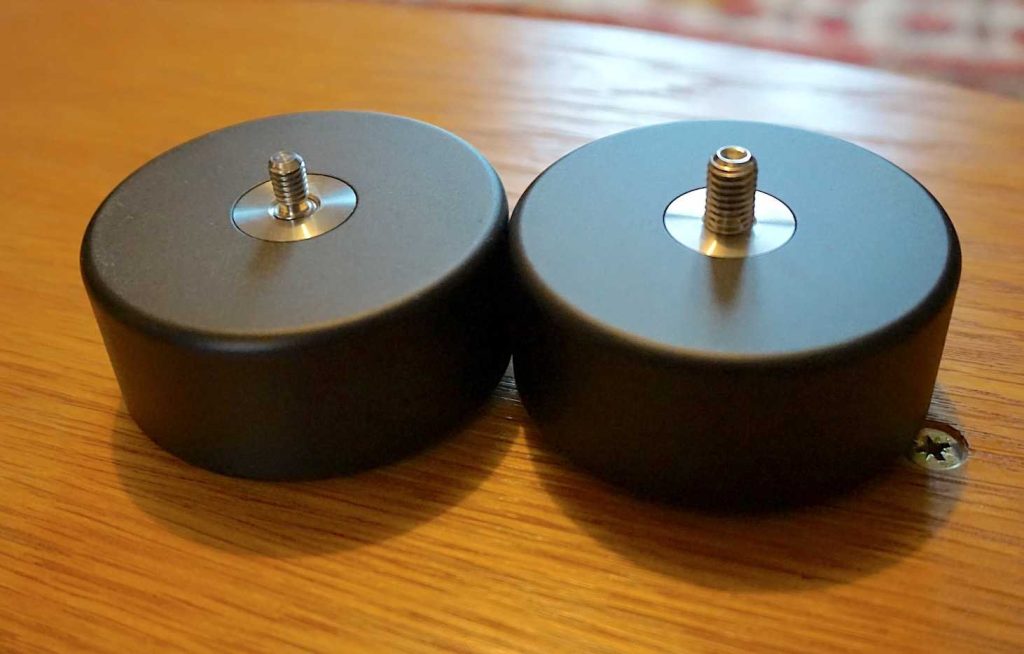
During installation, it’s up to you, you can first screwed the bolts into the stand, then the feet onto the bolts or you can screw the bolts into the feet first and then offer the whole thing up to the speaker and screw the bolt in from there. Either way is fine. Whatever way you decide to go, the operation took a few of minutes in total.
After that, I added felt pads to the feet. Spikes are included but I’m not a fan of spikes…on anything, to be honest. Besides, I have rugs on wooden floors. The spikes posed immediate damage to the flooring and so I used a felt pad in place of the spikes. The pads I used were added to the AUVA 70 feet by removing a protective backing and then sticking the pad directly to the foot itself. AUVA 100 pads are a tad different but we’ll get to that later.

Once in place, the stands were remarkably stable. Solid, in fact. A lot more secure in the usual position than before, put it that way.
Oh and before I carry on? I tested pre-production samples so if you see any imperfections within the images posted here? That’s why. They’ll be swish and shiny when they are finally sold to the populous at large.
So how did they perform?
SOUND QUALITY
I turned to a CD I had review quite a while back. One I liked but haven’t listened too in a long time. I suppose you’d call this one a world music genre piece, as much as I dislike that tag but I use it here because others will then know what direction this music moves into.
Created by Aziza Brahim, the CD was released by Glitterbeat. Called Abbar el Hamadait, it is a bit of a stunner, especially my test track, a sumptuous romantic piece called El canto de la Arena featuring a melancholy female vocal, a slow-paced yet chocolatey romantic guitar, bass guitar, pipes, small sets of bells and a host of organic percussion (no digital is allowed in this one) the type of which I have no clue so please forgive my ignorance. They sounded wonderful though. Deep, tight when hit and effective.
The whole thing sounded beautifully exotic – well it does to a lad from Liverpool, at any rate. Then again it wasn’t that long ago when Chocolate Bourbon Biscuits sounded exotic to me so it doesn’t take much – with a swaying, slightly dreamy dance feel that could go on for days and disappoints when finishes. That kind of music.
AUVA 70
With the Stack Audio AUVA 70 feet in place?
Errr, blimey! I mean….blimey! I felt like I needed to suddenly sit up straight and pay attention. I actually did do that, without realising. As if the music had just woken up. The entire soundstage was suddenly precise and focused. The mids were crisp. The treble was exacting. The bass was even tighter than before. It started and stopped on a pin head.
I really didn’t expect such a change in the sound.
Even the vocal that sat on the centre of the stereo image. I never realised before that this position sounded a little fuzzy. That was my ‘norm’. My default. I didn’t even realise there was a problem until I used these feet. Now the stereo image was placed with mathematical precision. It was like a big bloke with a luminous green jacket and a Theodolite had paid my listening room a quick visit. The sheer accuracy of the vocal now was very impressive indeed.
Because of this almost mathematical precision, the supreme focus, the removing of even a hint of wooly bass or slightly meandering mids, everything sounded clearer now. Vocals, the actual lyrics, were more easily understood. Nothing got in the way of the delivery any more.
To repeat though, I didn’t even know it had. I thought everything was hunky dory. I thought my system sounded pretty good, to be honest. These feet told me I that I had been living a lie, all this time.
The delivery before the feet now sounded as if the poor girl was mumbling. At least when you take the ‘before and after’ into consideration.
More than that, when harmony backing singers were introduced, the stereo image was pushed back into 3D space, giving the soundstage real depth now.
Before this test, I considered the Quad 57s – for the price – the best speakers in the world. Bar none.
Since I added the feet, that estimation has gone upwards!
TECHNICS SB-C600
I then tried a pair of diminutive Technics SB-C600s on my HiFi Racks stands. Again, I had to use the M6/M8 convertor bolts for these stands and once more, once in place, the Stack Audio feet added the sort of stability to these stands that I have never before experienced. They’re big, chunky, solid feet. It’s like adding a set of Land Rovers to your speaker stands. Four-by-four, indeed.
I then played a glockenspiel section of Mike Oldfield’s Incantations via vinyl and again, serious impressive in performance terms.
The glockenspiel itself was so precise, so on the nose that it sounded like the fall of musical raindrops. Such was the accuracy of the delivery here. And accuracy is really the over-riding word. Accuracy is the headline of this review. The AUVA 70 feet dial in the music to a level of exactness that I have never really had before, across my entire HiFi system.
PMC twenty5.26i
I then quickly tested the 70s under a pair of £10k floorstanding speakers from PMC, the twenty5.26i speakers.
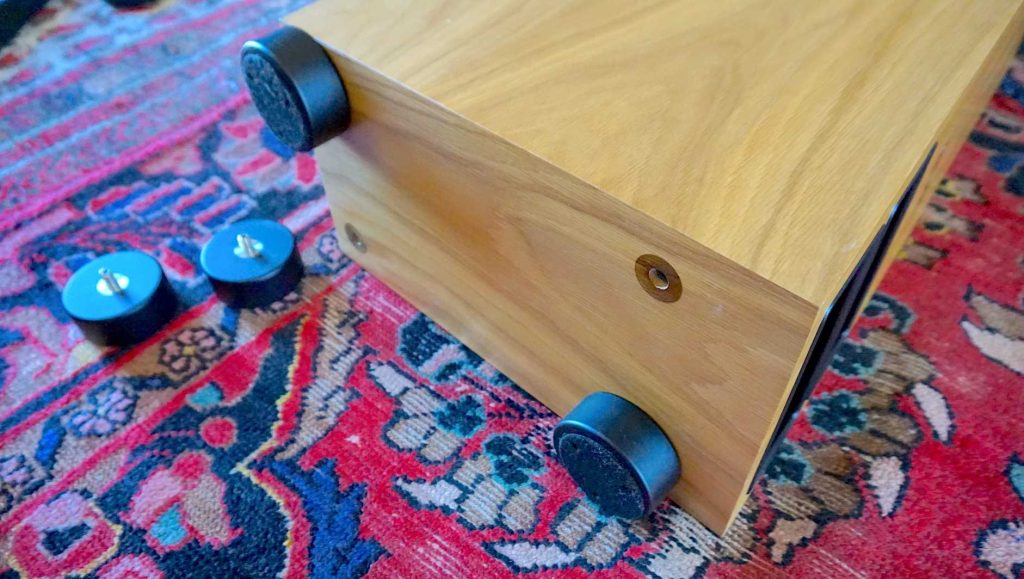
Using their default outrigger stands, the PMCs do lose a little control right at the edge of treble. You can really hear that during the Oldfield track where the edges of the treble output are a little fuzzy.
With the 70s in place the precision, focus and detail from the treble – but also every other frequency you might like to name – shot through the roof and added a new dimension from these expensive speakers. With the treble newly honed, I was also hearing reverb around this area for the first time and, because of that, space and secondary detail.
PODIUMS
Before I ended with the 70s, I wanted to bring in a pair of Townshend Podiums, to run an A-B with the AUVAs.
And well, well, well. I did not expect the sonic results from that pairing. When I reviewed the Townshend Podiums I gave them an award-winning rating and with good reason. They provide focus to the sound overall and they provide drama and an epic quality to the soundstage. They add clarity and organisation. And they remain excellent and I still highly recommend them.
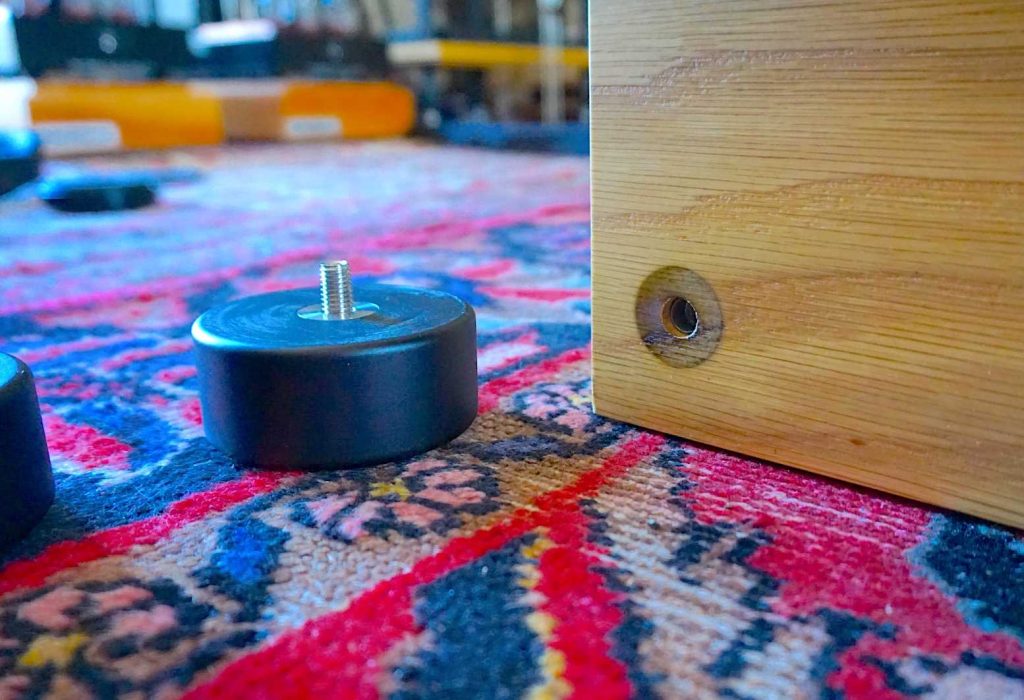
The AUVA feet, however? They go further. Further in terms of focus, precision, organisation and clarity. The Podiums give you that drama and the epic quality that the AUVA feet do not. And I’m sure some people will prefer the Podiums. They will like that blend of focus and organisation and the big sound.
But that’s because the AUVA feet are busy adding more focus and more precision. And because of that they really do define the start and end points of notes. So that Incantations glockenspiel I mentioned above? The treble here had those start/stop points and because those notes now existed in dazzling clarity, I was now hearing reverb from those end points and then more information because of that. And so on.
Stunning is a word that sprung to mind. I had no idea that a set of ‘mere’ speaker feet could do this. No idea. And yet, here they were.
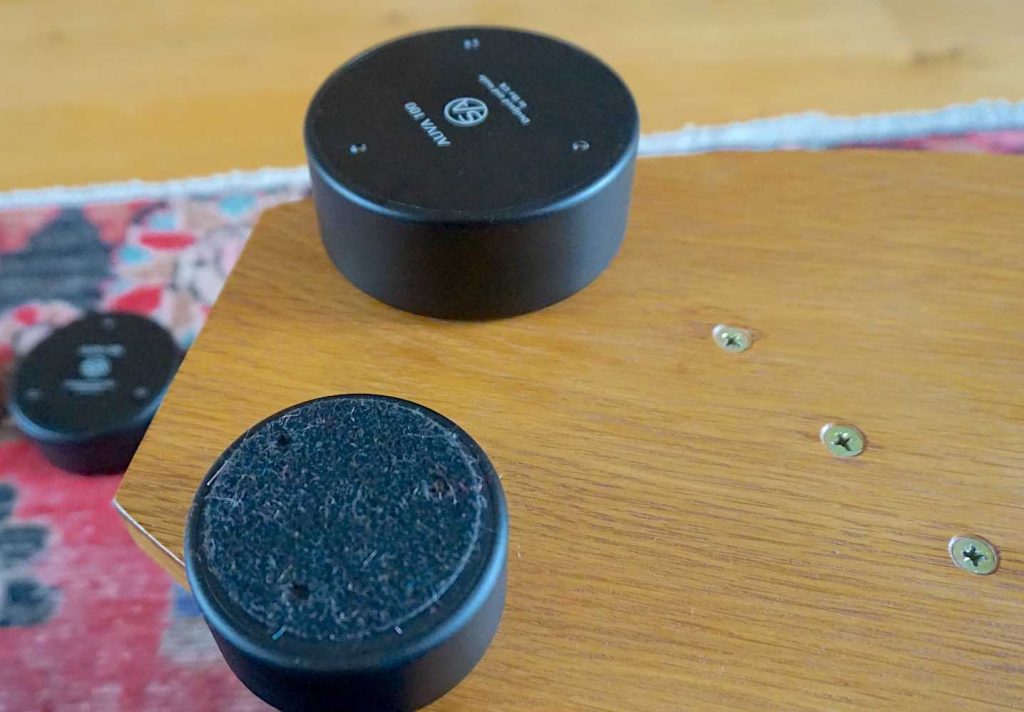
They look so darned simple. Yet they do so much. But that’s because of what’s going on inside I suppose.
AUVA 100
So, one final, final test then. What are the differences between the AUVA 70 and AUVA 100 feet, if any? I turned to Ella Fitzgerald’s version of One For My Baby on the Speakers Corner pressing of the Harold Arlen Song Book double album, originally out on Verve.
Differences, if any? Lots is what I’d say! But hear this, moving from the 70s to the 100s is to move from excellent hifi to truly high-end HiFi. And I mean top-of-the-line. It’s like moving from an exceptional boron cantilevered cartridge to a cartridge packing a sapphire or even diamond cantilever. That sort of standard.
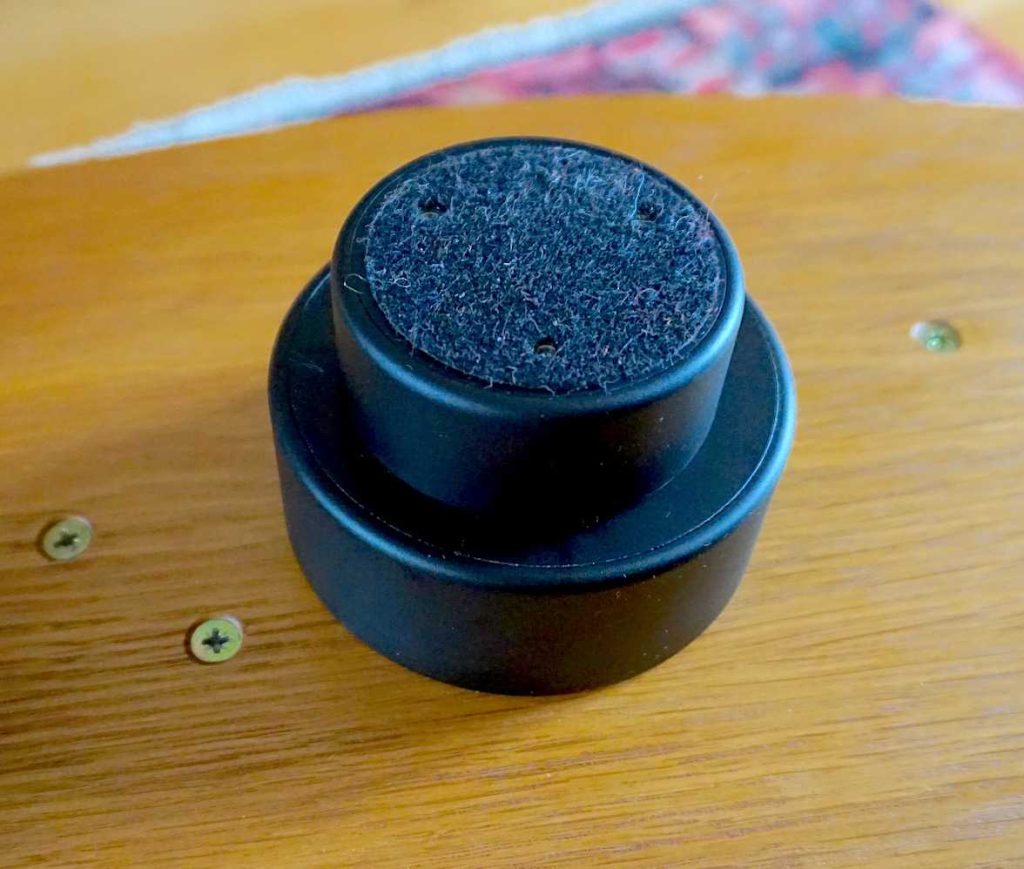
At this point, all talk stops. You’re forced to listen. There is a level of sound quality here which is just exceptional. Truly exceptional. In short? Down went the noise again, up came the detail.
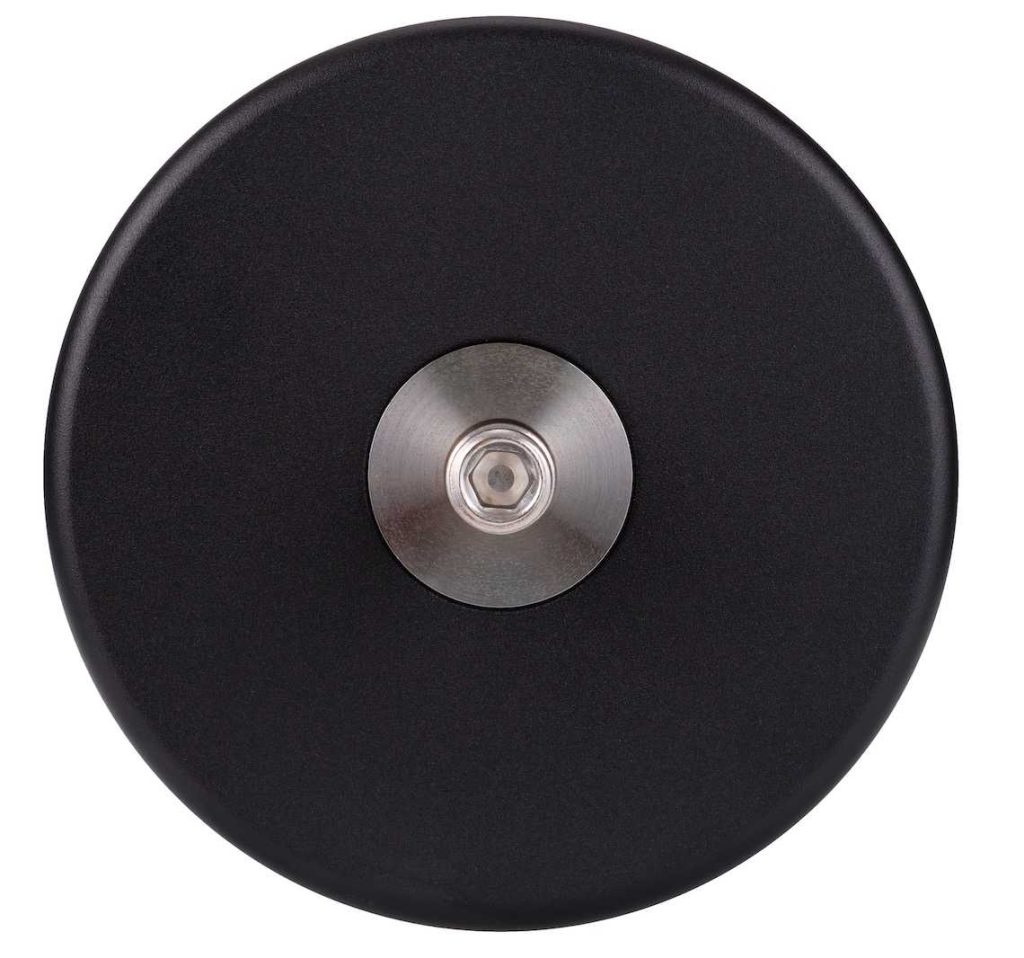
More than that? The Fitzgerald vocal had more body, more structure. Her bass notes were fuller, the tiny fluctuations in her delivery were better integrated now. That is, she sounded truly at ease for the first time.
So did the orchestra. Sax output offered a deep resonance, bass now held a foundation to the track rather than acting like a bit-part player and in terms of the upper mids and treble? There’s a mid-point crescendo where the orchestra and vocal builds to a wham-o final push to the end. At this crescendo, even the 70s found it tough to prevent the orchestra sounding a little screechy. The 100s took this point in their stride. The soundstage opened up, there was suddenly more resolution available to cope with the sudden increase in information and the result sounded impressive, loud, big but there was far more information on offer now.
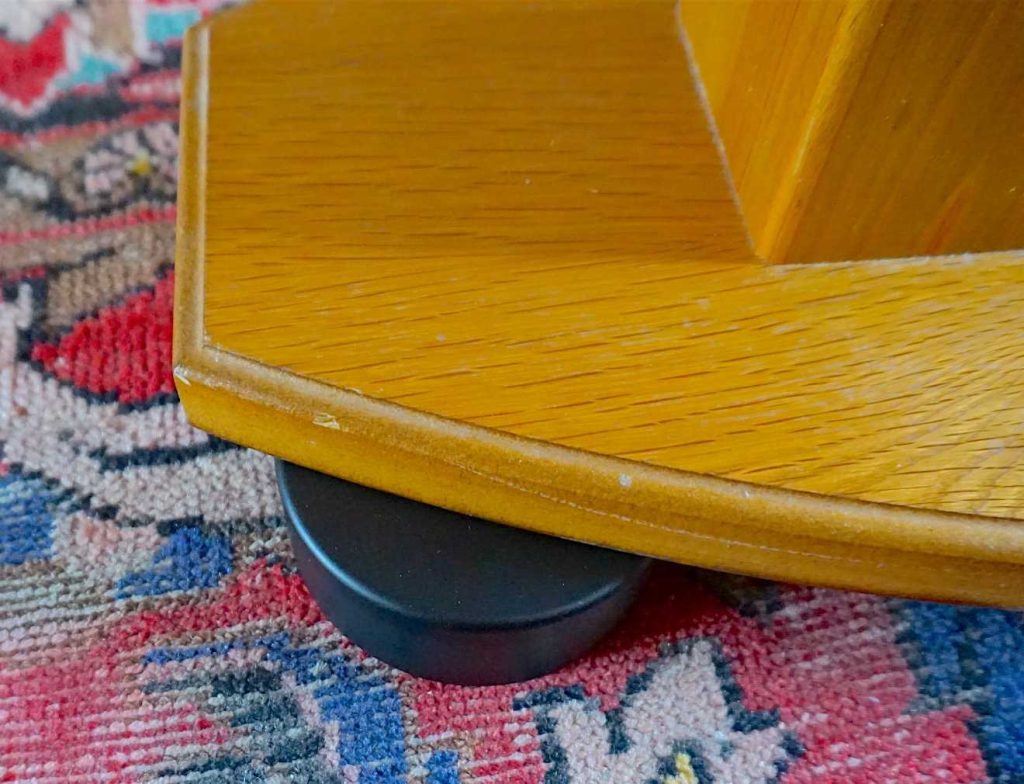
Turning to Krosia’s Transmission, a dreamy Balearic electronica piece from the Mental Wealth compilation album (Vinyl Moon), I was impressed with the broad yet firm bass. Bass was tight without ever feeling chrome hard. There remained ‘give’ here which provided a more naturalistic feel to the lower frequencies. The mids and treble was the big surprise. The latter were far more uplifting and expansive than I was used to. Glorious is a word that sprang to mind.
CONCLUSION
I expected some sort of improvement from the Stack Audio AUVA feet sure but nothing, nothing in sonic terms, quite like this. The sheer level of precision from the music now was quite outstanding. For my HiFi system, at least, it felt like the last ingredient to make the entire HiFi chain click into place. It’s almost like my HiFi system needed a big nudge to give it that sense of clarity – and I didn’t know. I didn’t know that was even necessary until I tested the AUVA feet.
The largest and most dramatic improvement was moving from basic feet to the 70s. That was a shock. Saying that, the move from the 70s to the 100s was a move to ‘proper HiFi’. High-end HiFi. HiFi that nods towards the sound and says, “Just stop what you’re doing and..take…a…listen…to…thisss.”
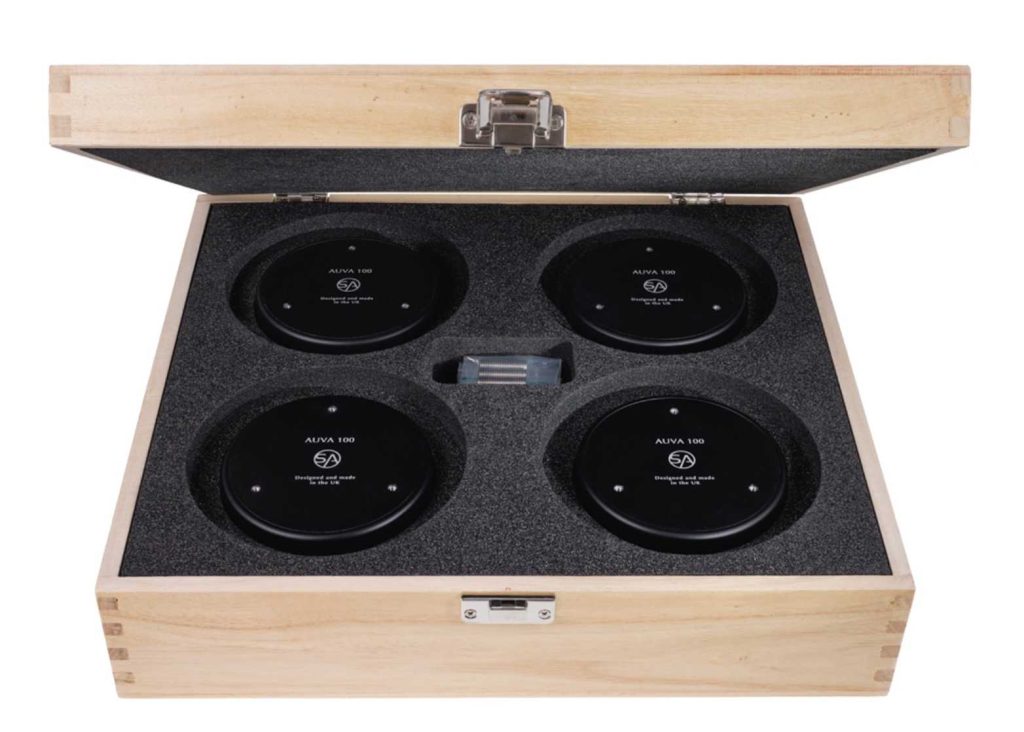
I’m very impressed with the sound from these feet, from my speakers and from my HiFi system as a whole. If you have the cash? Buy.
In terms of the design and what they do and how they do it and the price? They are revolutionary. And when products hit that level of performance? I can do no more than award that product a rare Golden Groovy. Congratulations to Stack Audio. They deserve it. And I hope they make a packet selling them too so they can wow us all with their next product. This sort of talent needs encouraging.
STACK AUDIO AUVA ISOLATOR SPEAKER FEET
Prices:
AUVA 70
- Set of Four: £420
- Set of eight: £840
AUVA 100
- Set of four – £620
- Set of eight – £1,240
You can try before you commit because there is a 30-day trial period available.
Website: stackaudio.co.uk
GOOD: precision, accuracy, focus, solid build, easy installation
BAD: nothing
RATING: 10
REFERENCE
Origin Live Sovereign turntable Origin Live Enterprise 12″ arm
Van Den Hul Crimson XGW Stradivarius Cartridge
Icon PS3 phono amplifier
Benchmark DAC
Aesthetix Calypso pre-amp
Icon Audio MB845 Mk.II Monoblock Amplifiers
Quad ESL-57 Speakers with One Thing mod
PMC twenty5.26i Speakers
Technics SB-C600 Speakers
Blue Horizon Professional Rack System
Harmonic Resolution Systems Noise Reduction Components
Air Audio AC-2K Balanced Transformer
Townshend Podium Speaker Supports
HiFi Racks Speaker Stands

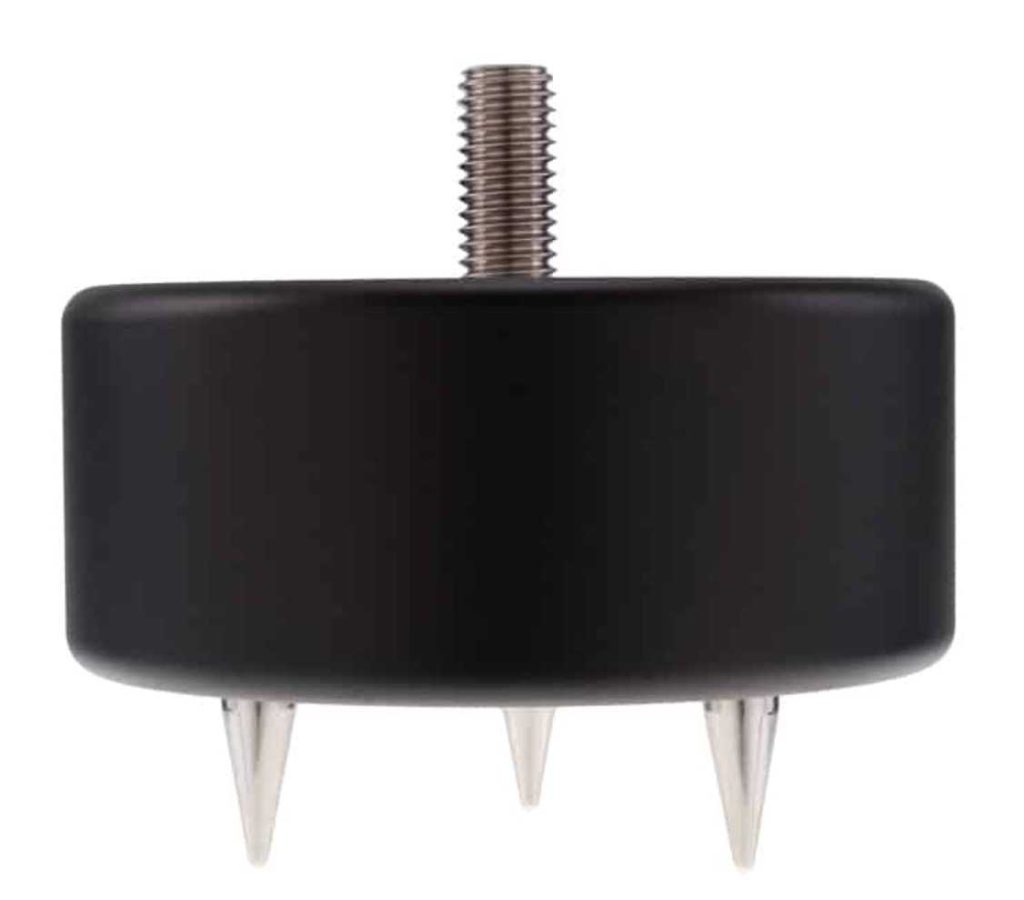
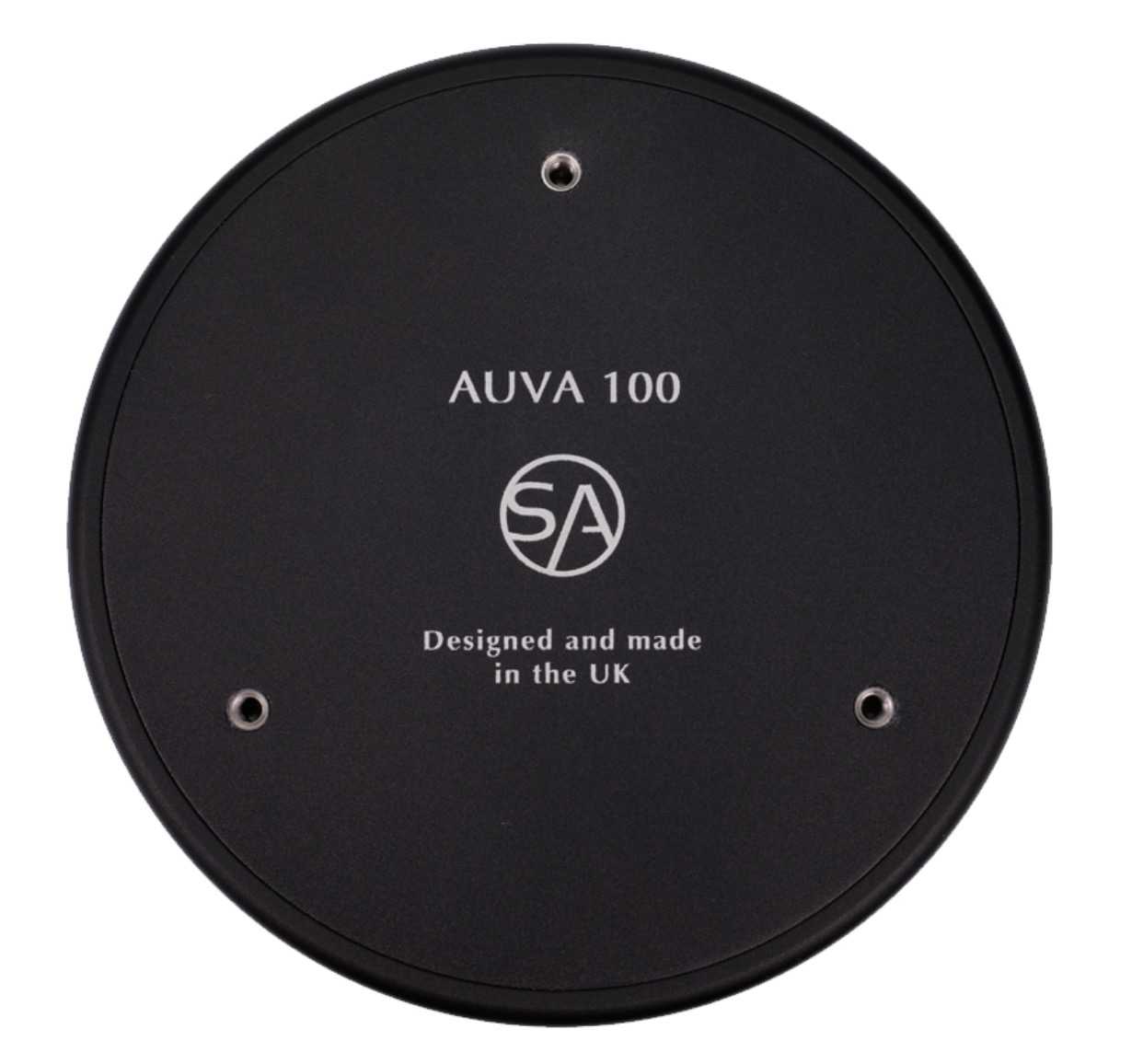
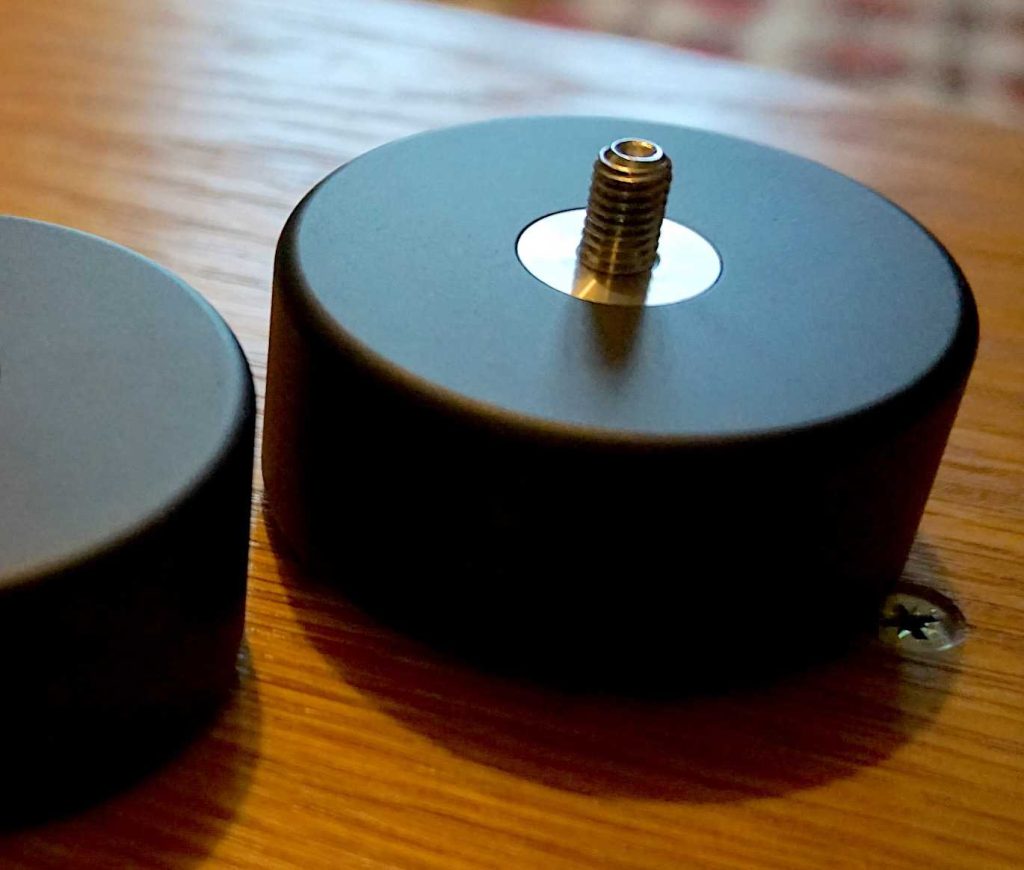
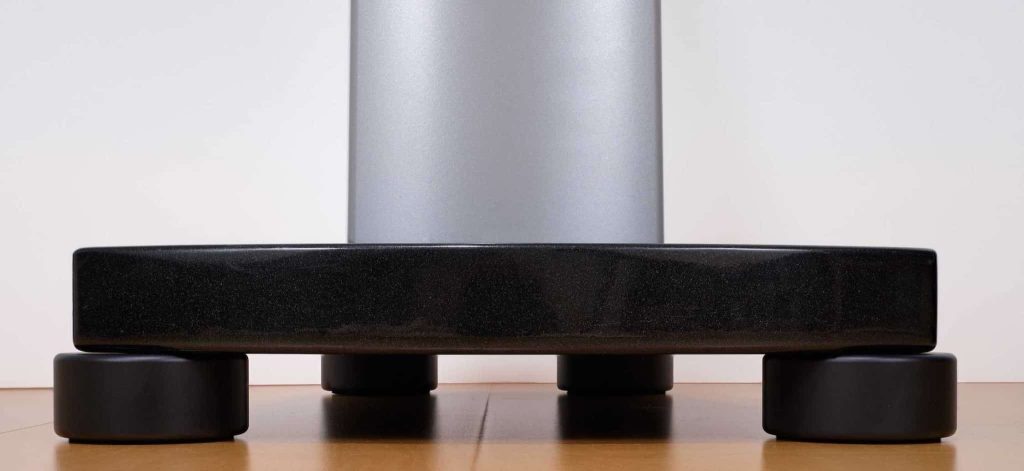
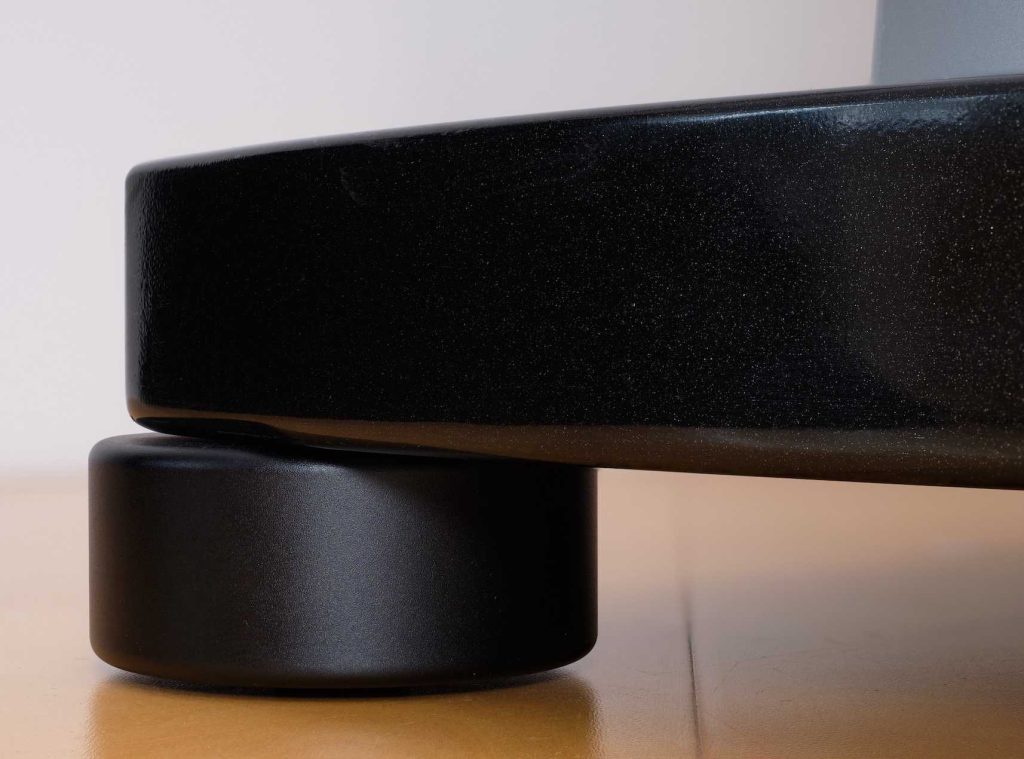
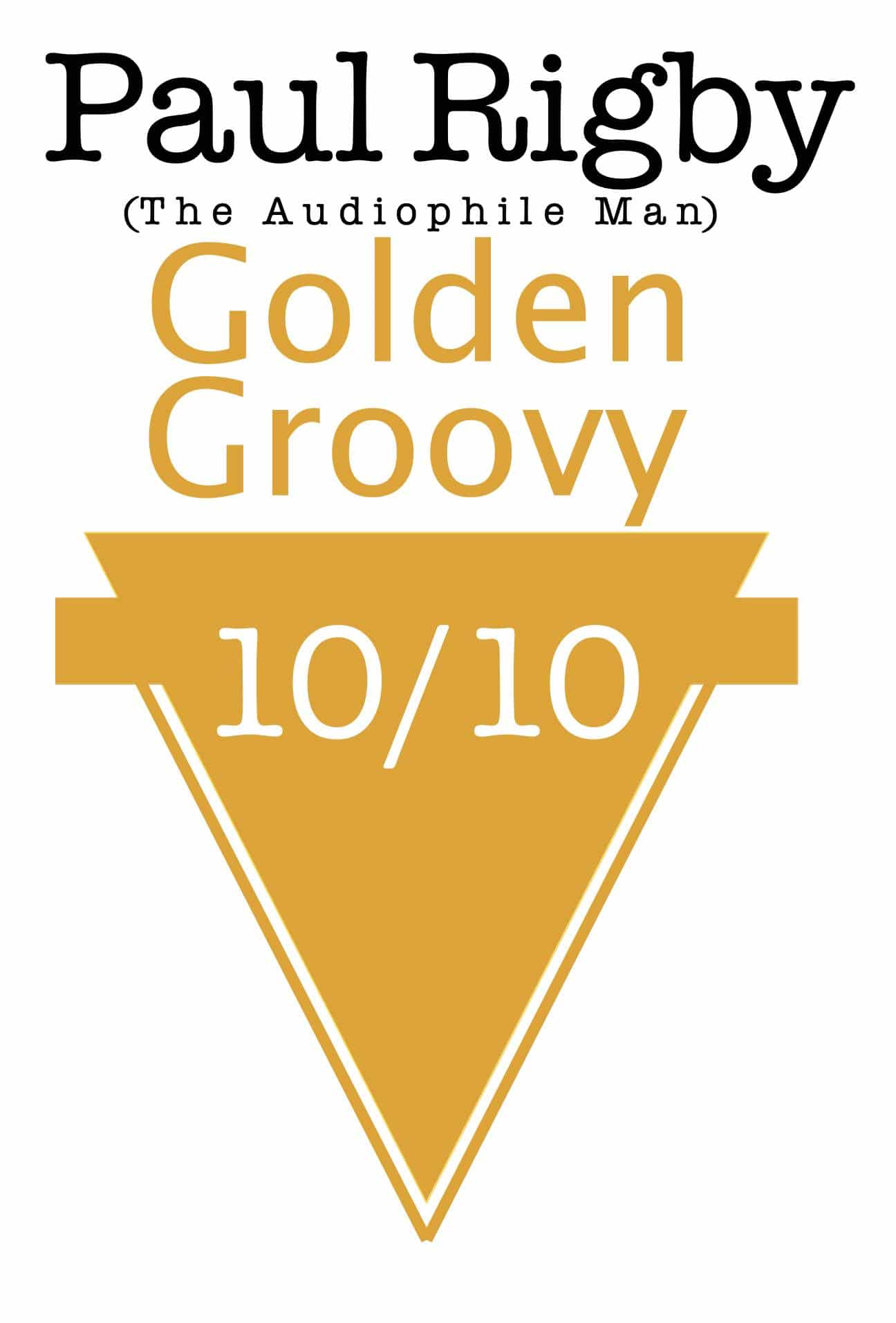


Product seems ok but who comes up with these prices?